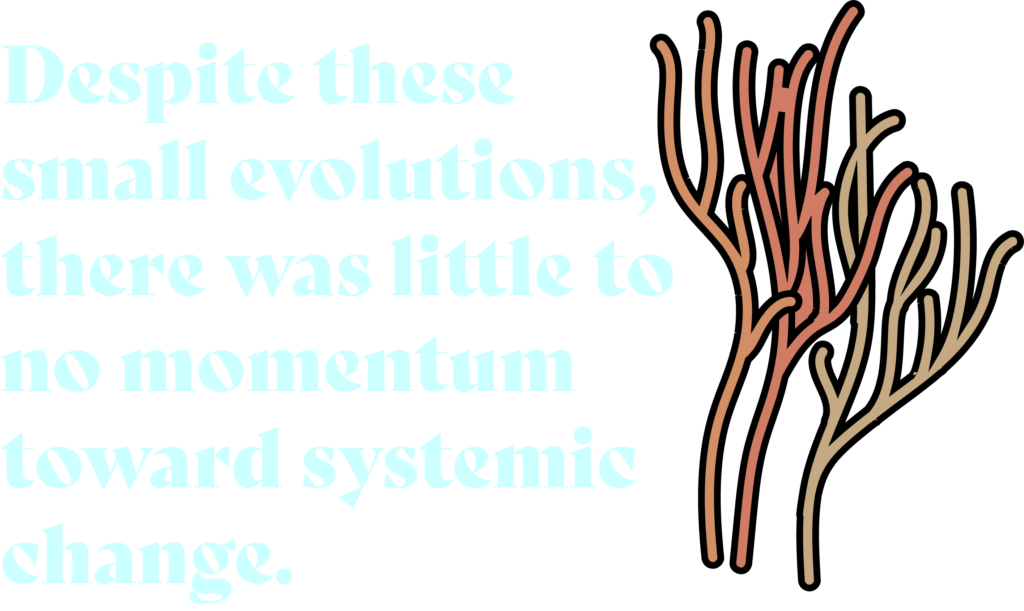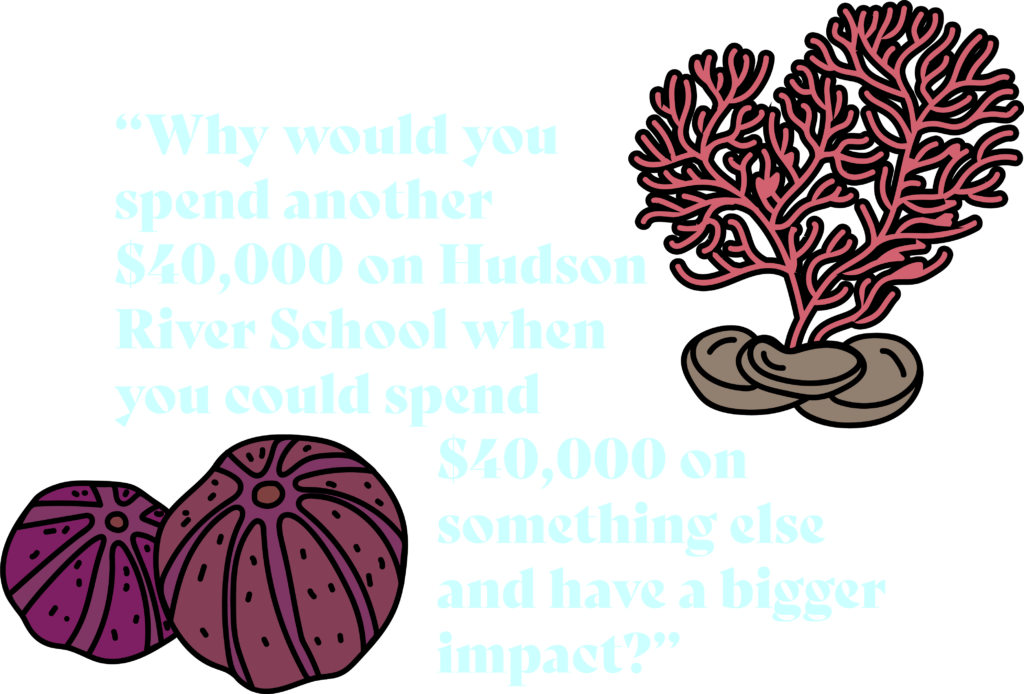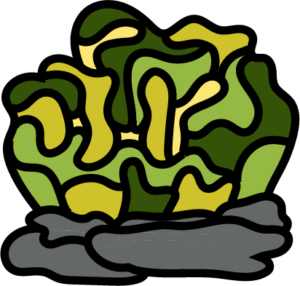

Written by Cecilia Johnson
Illustrations by Oliver Evans







salmon are swimming up the St. Mary’s River. The fish are jostling each other as they squeeze through the thin strips of water, brown and spotted, some of them nearly a meter long after a lifetime in the lakes. Their wriggling is pure determination.
Small and gleeful and a little afraid, you launch yourself into the teeming water. A rope circles your waist, tying you to land, but its intermittent tugs feel like whispers compared to the rush of water and fish. You breathe through a snorkel, occasionally gulping blue as the current pushes you under. As you watch the salmon, your lips curl around the mouthpiece in a smile.
Scott Pollock grins in his office as he recounts these childhood adventures. Pollock grew up on the Ontario side of Sault Ste. Marie, the industrial border city on Anishinaabe land, where he would jump into the Soo Locks with his friends. He canoed with his father and biked around the Batchewana reserve with his friends. He did not enjoy going to museums. “I always felt like culture and art—whatever that means—is something that’s felt,” he says. “I would go to museums and be super disappointed as a kid, because I didn’t feel culture there.”
“I always felt like culture and art—whatever that means—is something that’s felt,” he says. “I would go to museums and be super disappointed as a kid, because I didn’t feel culture there.”

It’s either shocking or perfect that Pollock is now the executive director of the Minnesota Marine Art Museum in Winona, Minn., having built a career on moving people via museums. Pollock performed audience research for the Art Gallery of Ontario from 2011-2012 and directed “museum experience” at the American Swedish Institute from 2012-2018. Since January 2021, he has been catalyzing change at the MMAM—not without some stakeholders’ chagrin, but certainly with the potential to change lives.

A group of Winonan businesspeople started it as the Minnesota Maritime Heritage Society, displaying nautical paintings and model ships in a building near the Mississippi River. Soon, local multimillionaires Bob Kierlin and Mary Burrichter became the museum’s chief backers. They used the space to exhibit their art collection, which was populated by Hudson River School landscapes, marine paraphernalia, and, later, Impressionist works by artists including Monet and Renoir.
The museum impacted many people over the years, including Ian Hanesworth, an artist who grew up in Winona. “I went quite a bit, especially in high school,” they say. “I would sketch in the galleries, and I would take workshops … it was a really meaningful place to me growing up.”

I went quite a bit, especially in high school,” they say. “I would sketch in the galleries, and I would take workshops … it was a really meaningful place to me growing up.”


and the Hudson River School landscapes propped up harmful narratives. “[Movement founder] Thomas Cole was all about the ‘pristine, untouched’ landscape of North America,” Hanesworth says. “And embedded in that was this idea that there weren’t people here [before white settlers] … which is so untrue, because humans have been caretaking and altering this place for thousands and thousands of years.”
 Regan Kluver, who works as a program specialist at the Minnesota Historical Society, never visited the MMAM despite earning a history degree at Winona State University. “I knew that the art museum was there,” she says. “It’s not something that was super grabbing to me.”
Regan Kluver, who works as a program specialist at the Minnesota Historical Society, never visited the MMAM despite earning a history degree at Winona State University. “I knew that the art museum was there,” she says. “It’s not something that was super grabbing to me.”
Kluver, who is a member of White Earth Nation, was already dealing with injurious art at WSU’s nearby Somsen Hall. A 1930s-era mural depicting historically inaccurate Dakota-settler relationships adorned the hall’s front entrance during Kluver’s orientation weekend. She says “I remember my mom looking at me, because she’s White Earth and Red Lake. She’s like, ‘I don’t think this is a place that you’re going to be safe in. Are you going to have people here that are gonna see you?’”
 WSU has since shrouded the mural as they figure out their next steps. But during Kluver’s time there, she says, community members advocated for keeping the painting in place. “People were like, ‘How dare you say you’re going to touch something that’s part of our history?’ It’s an older town, and when there’s change, there’s usually some arms that go up.”
WSU has since shrouded the mural as they figure out their next steps. But during Kluver’s time there, she says, community members advocated for keeping the painting in place. “People were like, ‘How dare you say you’re going to touch something that’s part of our history?’ It’s an older town, and when there’s change, there’s usually some arms that go up.”

Andy Maus also encountered resistance to change when he tried to evolve the MMAM as its executive director from 2010-2016. “I definitely wasn’t fully comfortable with how Eurocentric that institution was at that time,” he says. “The board has opinions, and the staff have opinions, and donors have opinions, and founders have opinions. I learned a lot about navigating differences.”
The museum’s curators programmed art from beyond the founders’ collection when they could. Jon Swanson and Dave Casey, the MMAM’s curator and assistant curator, respectively, had jurisdiction over two of the museum’s six galleries. Pollock says, “They were doing some really great work, like a Tony Duran show and an Alec Soth show. Last year, they did a show on Hmong quilts and looked at relationships to the Mekong River through textiles, and people fucking loved it. Or the dogs underwater, the [Seth] Casteels.” In the mid-2010s, buzzy exhibitions helped supercharge the museum’s annual attendance from 15,000 to 25,000.
 But after Pollock’s predecessor, Nicole Chamberlain-Dupree, stepped down in 2021, museum staff were unanimous in supporting Pollock for executive director. Pollock adds, “The board saw in me this opportunity to really expand the vision for what great art inspired by water looks like. I am personally motivated by that: much broader narratives folded into this whole conversation.”
But after Pollock’s predecessor, Nicole Chamberlain-Dupree, stepped down in 2021, museum staff were unanimous in supporting Pollock for executive director. Pollock adds, “The board saw in me this opportunity to really expand the vision for what great art inspired by water looks like. I am personally motivated by that: much broader narratives folded into this whole conversation.”

Powered by Pollock’s bountiful energy and the staff’s hard work, the MMAM has expanded its programming and vision beyond a “literal depiction of water’s aesthetic beauty”—as Pollock characterizes the work in Kierlin and Burrichter’s collection—to a wider mix of media and interpretations. A recent show, Flora, featured prints and sculpture of plants, honoring the fact that water is integral to all plant life. Another show called Fauna centers animal life. A new “literary arts gallery” showcases illustrations from three nature-focused books published by Minnesotan presses.
 In order to weave what Pollock calls “social fabric connections,” the museum has programmed artist residencies; community conversations; and events including quarterly $1 admission days, a paddle-making workshop, and an outdoor concert performed by contemporary singer/songwriter Sam Amidon and members of the Winona Symphony Orchestra. (The reduced admission days were first implemented during Chamberlain-Dupree’s tenure in 2018.) Founders Kierlin and Burrichter “saw value in—and wanted—higher attendance numbers,” Pollock says. But now, the museum’s curators and front-of-house staff have shifted their focus from the quantity of visitors to the quality of those visitors’ experience.
In order to weave what Pollock calls “social fabric connections,” the museum has programmed artist residencies; community conversations; and events including quarterly $1 admission days, a paddle-making workshop, and an outdoor concert performed by contemporary singer/songwriter Sam Amidon and members of the Winona Symphony Orchestra. (The reduced admission days were first implemented during Chamberlain-Dupree’s tenure in 2018.) Founders Kierlin and Burrichter “saw value in—and wanted—higher attendance numbers,” Pollock says. But now, the museum’s curators and front-of-house staff have shifted their focus from the quantity of visitors to the quality of those visitors’ experience.
This transition—more of an identity shift than just a leadership change—has been difficult. Months after Pollock started his new job, Kierlin and Burrichter sent one of the museum’s top-billed paintings, Washington Crossing the Delaware by Emanuel Leutze, to auction. This Washington is the smaller sibling of the one at the Metropolitan Museum of Art, and it hung in the White House for years before ending up in the MMAM in 2015. It sold for $45 million at Christie’s last year. Some community members and docent-volunteers are crestfallen that it’s gone.
 But Pollock, who does not have an art history background, has priorities beyond Washington and several other paintings’ departures. “I think the role of museums is to actually have people shift their perspective; have conversations,” he says. In addition to the aforementioned community engagement events, Pollock and the staff have planned 2024 and 2025 exhibitions focusing on water-related racial and environmental justice.
But Pollock, who does not have an art history background, has priorities beyond Washington and several other paintings’ departures. “I think the role of museums is to actually have people shift their perspective; have conversations,” he says. In addition to the aforementioned community engagement events, Pollock and the staff have planned 2024 and 2025 exhibitions focusing on water-related racial and environmental justice.
Plus, Washington’s departure has created an opportunity as much as an inventory issue. “It opens the door to the possibility of being a solution to many other problems that museums are facing, which is 90% of the objects are in storage,” Pollock says. “We now have this beautiful curatorial angle that’s unique. We have this beautiful building that is bomb-proof, and you could bring any artwork.”
Plus, the museum can now pay local curators and artists, such as Hanesworth and Annie Hejny, for their work. Pollock paraphrases board member Tamara Aumauput:

“I like to say that the river raised me,” Hanesworth says.

“I grew up going to Stoddard, Wisconsin, to see my great-grandpa every weekend … so I grew up swimming in the river, poking dead fish and digging stinky mud. There’s sort of an intuitive childhood relation of animacy with the landscape—regarding it as spiritual and not really questioning that.”
Kluver says, “I don’t want to be so ‘basic Native’ and be like, water is life. But it is, right? … It’s how my daughter got here. It’s how I got here. It’s healing. It’s how we take care of one another.”
Pollock’s first memory is set in Lake Superior Provincial Park in Ontario. “I was sitting on a rock on a hot sunny day,” he says. 


Contributors



